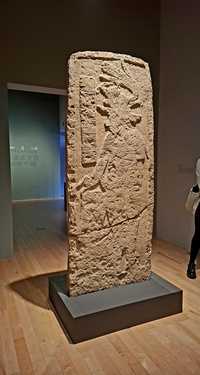Puebla campus offers a glimpse into the environmental and cultural legacy of a "living river."

Puebla campus offers a glimpse into the environmental and cultural legacy of a living river.
Stelae of the Usumacinta, part of an investigation by Sandra Rozental, Emilio Chapela and Eduardo Abaroa // Opens tomorrow at the Amparo Museum
Paula Carrizosa
The Eastern Journey
La Jornada Newspaper, Friday, June 20, 2025, p. 5
Puebla, Pue., Limestone stelae seen as doors to understand the Mayan culture, as they are a record of their conflicts, battles, perception of the world and the way they interpreted natural events, and also stela, that water mark left by a boat when traveling down a river, thus, between the two meanings of that concept, the exhibition Stelas of the Usumacinta was prepared, research by Sandra Rozental, Emilio Chapela and Eduardo Abaroa, which will open tomorrow at the Amparo Museum.
We like to think about the traces left behind by cultures, living beings, and communities; like the way water leaves meanders (...) We try to compress all of these processes into the exhibition's narrative
, explains artist Eduardo Abaroa.
In a conference, he points out that this exhibition covers from the upper part of the river, in Guatemala, to its mouth in the Gulf of Mexico, flowing between the museum's halls as if they were the regions through which the basins of this tributary flow, whose current name is a vestige of colonial processes
, since the Spanish gave it the name of Usumacinta, in Nahuatl, river of the sacred monkey
.
The regions are diverse in biological, geographical, cultural, historical terms (...) We try to represent that through sculptures, videos and many texts, since it is an exhibition designed to be read
, noted Abaroa, who alongside Rozental and Chapela presents the eponymous piece of the exhibition that is housed in the lobby of the Amparo Museum, with pieces that refer to the Planchón de las Figuras, a rock outcrop in which human silhouettes, monkeys, reptiles and spirals are represented, which are replicated here with henequen, a material native to the Mayan region.
A tributary that is disappearing
In turn, Emilio Chapela mentioned that the idea that the Usumacinta is the only living river
in Mexico motivated them to investigate more about this tributary that is being lost, since the only thing that is protected is the Lacandon jungle, while there are problems with the macaw; there is a plague of the devil fish, which erodes the river banks, in addition to the threat of industry on the howler monkey and the manatee, proof of which is its population, the first in Mexico to be displaced by climate change
.

▲ The exhibition is supported by the Patronato de Arte Contemporáneo (Contemporary Art Trust) and will run until January 4. Photo by Paula Carrizosa
The artistic researcher and member of the National System of Creators noted that having made trips and forays to the area, he found the number of things that are interconnected in cultural and biological terms relevant, since there is a true tangle of links
.
Thus, the author of the Omega del Usumacinta sculpture proposed to think that the river was alive beyond the quality of the water, that it maintained deep and real connections and links, referring to water, ecology, cultural heritage, the Mayan history of navigation, the extraction of wood, chewing gum, lizard skins, the Lacandon jungle and surrounding ecosystems
.
Anthropologist Sandra Rozental indicated that the exhibition also reflects on the way in which Mayan art production is present in museums and how it reached them, as it is related to the processes of extractivism
; for example, the stela known as The Queen, which was extracted from Yaxchilán and abandoned on the riverbanks by authorities from the National Museum of Anthropology who intended to take it to Mexico City; it was finally rescued by Gertrude Duby, a scholar of local culture and its stones, who recovered it and returned it to its place of origin.
He concluded that, therefore, the Stelas of the Usumacinta exhibition also seeks to problematize where these objects belong, such as the Mayan pieces in the Pre-Hispanic Art Collection of the Amparo Museum and, at the same time, to reconcile with that which has been separated or stripped, as noted by the museum's director, Ramiro Martínez, for whom the exhibition speaks of a reconciliation with that river
, a pertinent idea in the midst of a context in which there are ecological and social battles
.
The exhibition is carried out with the support of the Contemporary Art Board.
It will remain on display until January 4, 2026, in the temporary exhibition halls and lobby of the museum located at 2 Sur 708, in the Historic Center of Puebla.
jornada




